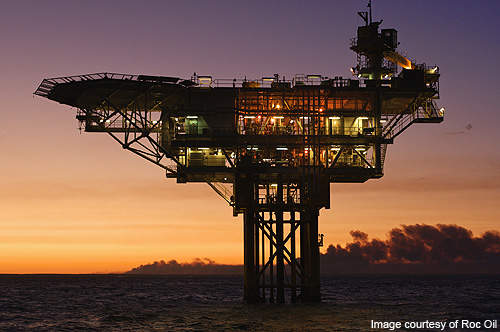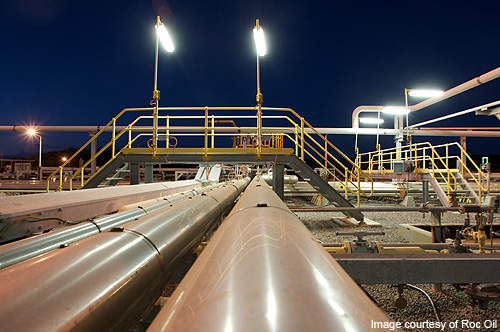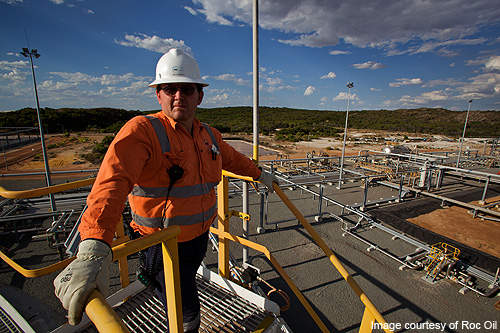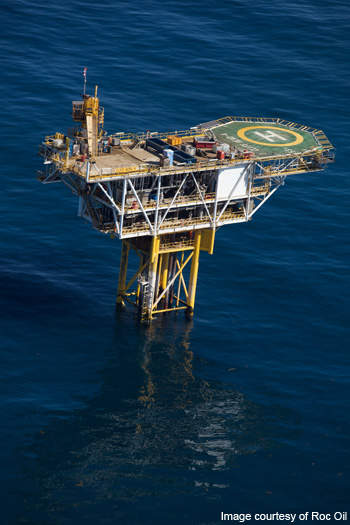Cliff Head oil field is situated 11km off the coast of Western Australia at a water depth of 16m. The field covers 6km² in the Commonwealth exploration permit WA-286-P and is the first to be developed in the offshore Perth Basin. The development cost of the field was A$327m and first oil achieved in May 2006.
Roc Oil is the operator of the field with a 37.5% interest. Partners include AWE Oil (27.5%), ARC, a fully owned subsidiary of AWE, (30%) and CIECO Energy Australia (5%).
Cliff Head field discovery
The Cliff Head field was discovered in December 2001 by the Cliff Head-1 discovery well. Drilled by the ENSCO 56 jack-up rig, the well encountered a 5m oil column. Between 2002 and 2005, three appraisal wells were drilled, confirming the presence of hydrocarbons at the field. A production test carried out on one of the wells, stabilised rates of up to 3,000bpd were observed.
Geology and reserves
Cliff Head produces from Permian sandstones of the Dongara Formation and Irwin River Coal Measures, sealed by the Triassic Kockatea Shale.
The proven and probable reserves of the field were initially estimated at 14.8 million barrels, but revised to 17.8 million barrels at the end of 2010. The proven and probable reserves remaining as at 31 December 2010 were 7.5 million barrels.
The oil is waxy and viscous in nature with an API of 330. It has high pour point and very low gas-to-oil ratio.
Field development
The final investment decision to develop the field was taken in March 2005. The field development plan included six production wells and two water injection wells. Between October 2005 and December 2005, the Ensco 67 jack-up rig completed the drilling of the wells. The production wells are fitted with ESPs (electric submersible pumps), which provide down-hole pressure and temperature monitoring.
In January 2010, Roc Oil completed a workover to replace an ESP at the CH-10 production well. The new ESP increased field production rate to 5,000bpd. A new ESP was also installed at the CH-6 production well.
Roc Oil is currently exploring potential reserves near the field. In January 2011, installation of a higher-rate ESP at production well CH-12 was initiated.
Production
The oil produced by the six production wells is collected by the Cliff Head platform for initial processing. It is then transported to the Arrowsmith processing plant, which was purpose-built to process the crude oil from the field.
Cliff Head Alpha platform
Cliff Head field is developed using an unmanned wellhead platform installed at a depth of 18m. The platform, installed in December 2005, is supported by a four leg jacket weighing 250t. It features nine slots for production and water injection. Topsides of the platform weigh 500t and feature a helideck and cranes. Both the topsides and jacket were fabricated at Lumut in Malaysia.
Subsea system
The subsea system includes a 14km-long insulated subsea production pipeline of 250mm diameter, which carries the produced oil to the Arrowsmith processing plant.
A 14km-long 250mm diameter subsea water injection pipeline connects the Arrowsmith processing plant to the field platform. A subsea umbilical power, control and chemical cable from the processing plant to the platform is also part of the subsea system.
Processing systems
The Arrowsmith plant receives crude via the production pipeline and separates the oil from produced water. The oil is stabilised before transporting to BP’s oil refinery at Kwinana, near Perth. The plant also features water injection pumping capability.
Contracts
WorleyParsons provided site investigations and geotechnical services for the platform, pipeline and the Arrowsmith plant.
In 2005, Coe Drilling was awarded a contract for providing drilling services for installing the production pipeline and umbilicals.
Plexal Group was awarded an engineering services contract for the field in 2006. Plexal won a second contract in 2009 to design a substructure to support a hydraulic workover unit for the platform.
Bass Marine carried out mooring inspections at the field. It is also responsible for long-term cargo transfers for the platform. RISC, an independent engineering consultant, was involved in the pre-construction and engineering phase of the field.
Weatherford International provided drilling services for the field.
ICON Engineering was contracted to install and commission the platform and topsides at the field.





